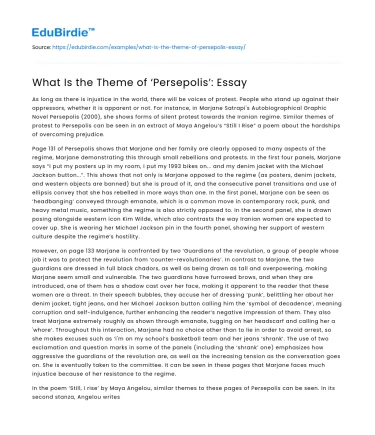As long as there is injustice in the world, there will be voices of protest. People who stand up against their oppressors, whether it is apparent or not. For instance, in Marjane Satrapi's Autobiographical Graphic Novel Persepolis (2000), she shows forms of silent protest towards the Iranian regime. Similar themes of protest to Persepolis can be seen in an extract of Maya Angelou’s “Still I Rise” a poem about the hardships of overcoming prejudice.
Page 131 of Persepolis shows that Marjane and her family are clearly opposed to many aspects of the regime, Marjane demonstrating this through small rebellions and protests. In the first four panels, Marjane says “I put my posters up in my room, I put my 1993 bikes on... and my denim jacket with the Michael Jackson button...”. This shows that not only is Marjane opposed to the regime (as posters, denim jackets, and western objects are banned) but she is proud of it, and the consecutive panel transitions and use of ellipsis convey that she has rebelled in more ways than one. In the first panel, Marjane can be seen as ‘headbanging’ conveyed through emanate, which is a common move in contemporary rock, punk, and heavy metal music, something the regime is also strictly opposed to. In the second panel, she is drawn posing alongside western icon Kim Wilde, which also contrasts the way Iranian women are expected to cover up. She is wearing her Michael Jackson pin in the fourth panel, showing her support of western culture despite the regime’s hostility.
However, on page 133 Marjane is confronted by two ‘Guardians of the revolution, a group of people whose job it was to protect the revolution from ‘counter-revolutionaries’. In contrast to Marjane, the two guardians are dressed in full black chadors, as well as being drawn as tall and overpowering, making Marjane seem small and vulnerable. The two guardians have furrowed brows, and when they are introduced, one of them has a shadow cast over her face, making it apparent to the reader that these women are a threat. In their speech bubbles, they accuse her of dressing ‘punk’, belittling her about her denim jacket, tight jeans, and her Michael Jackson button calling him the ‘symbol of decadence’, meaning corruption and self-indulgence, further enhancing the reader’s negative impression of them. They also treat Marjane extremely roughly as shown through emanate, tugging on her headscarf and calling her a 'whore’. Throughout this interaction, Marjane had no choice other than to lie in order to avoid arrest, so she makes excuses such as ‘i'm on my school’s basketball team and her jeans ‘shrank’. The use of two exclamation and question marks in some of the panels (including the ‘shrank’ one) emphasizes how aggressive the guardians of the revolution are, as well as the increasing tension as the conversation goes on. She is eventually taken to the committee. It can be seen in these pages that Marjane faces much injustice because of her resistance to the regime.
In the poem ‘Still, I rise’ by Maya Angelou, similar themes to these pages of Persepolis can be seen. In its second stanza, Angelou writes “Does my sassiness upset you? Why are you beset with gloom? ‘Cause I walk like I've got oil wells pumping in my living room.” The use of simile comparing Angelou’s walk to that of someone who has “oil wells” in their living room conveys how prideful she is, as oil is an extremely valuable substance and something to be proud of having access to. In relation to Persepolis, Marjane proudly displays her western objects and memorabilia, as seen through her hanging up the posters her parents brought her in her room, as well as wearing forbidden clothing such as her jacket and jeans. The line “Does my sassiness upset you?” also relates back to Persepolis, as the guardians of the revolution are infuriated by Marjane expressing herself through banned items, just as the people Angelou is referring to in her poem are infuriated by her “sassiness”.
In the sixth stanza, Angelou says “You may shoot me with your words, you may cut me with your eyes, you may kill me with your hatefulness, but still, like air, I’ll rise”. The metaphors used in this stanza convey the great injustice Angelou faces in a descriptive and dynamic way. For instance, somebody glaring at her is referred to as “cutting(ting)” her with their eyes. This shows how deeply harmful injustice is to Angelou, comparing it to being cut by whoever is glaring at her, a serious and damaging crime. This can be related back to pages 133 and ??? of Persepolis, as Marjane is shown hate and injustice by the guardians of the revolution. However Angelou also ends this stanza (as she does with the rest of them too) with “...still, like air, I rise”, showing that she tries her best to not let these hateful actions essentially ‘bring her down’. This can be seen reflected in Marjane, as even though the guardian’s actions affect her negatively in this chapter, throughout the rest of the book, she continues to express who she wants to be, despite it going against the regime and potentially getting her into trouble.
To conclude, both Marjane Satrapi and Maya Angelou both portrayed themes of protest and rebellion in their respective works. This has been achieved through language and visual techniques, both Persepolis and still I rise received public acclaim for their success in depicting protest and rebellion.






 Stuck on your essay?
Stuck on your essay?

